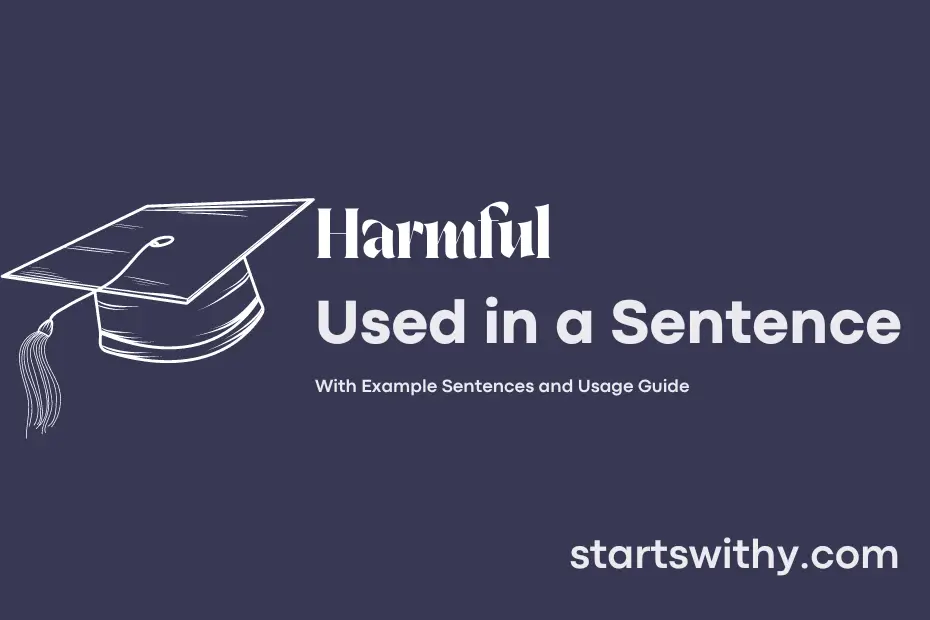Ever come across a sentence that’s packed with a potential warning or danger? That’s a harmful sentence. These types of sentences contain words or phrases that can inflict negative consequences, whether emotional, physical, or otherwise. They often serve as cautionary tales or highlight the risks associated with certain actions or behaviors.
Identifying harmful sentences is crucial for effective communication and message delivery. Understanding their impact can help writers and speakers convey their intended message clearly and responsibly. By recognizing and avoiding harmful sentences, we can uphold ethical standards, promote safety, and ensure our words have a positive influence on others.
7 Examples Of Harmful Used In a Sentence For Kids
- Eating too much candy can be harmful to your teeth.
- Remember to always look both ways before crossing the street to avoid harmful accidents.
- It’s important to wear a helmet when riding a bicycle to protect yourself from harmful head injuries.
- Washing your hands before eating helps to get rid of harmful germs.
- Too much sun exposure can be harmful to your skin, so remember to wear sunscreen.
- Drinking too much soda can be harmful to your body, so it’s best to drink water instead.
- Always be careful with sharp objects like scissors to avoid harmful cuts.

14 Sentences with Harmful Examples
- Harmful habits like excessive drinking and smoking can have a negative impact on your health.
- It is important to be aware of the harmful effects of plagiarism on your academic career.
- Consuming too much junk food can be harmful to your overall well-being.
- Lack of exercise and physical activity can be harmful for both your physical and mental health.
- Harmful rumors and gossip can damage relationships and reputations within college communities.
- Falling into a cycle of procrastination can be harmful to your academic performance.
- Ignoring mental health issues can be harmful and impact your overall well-being as a college student.
- It’s important to be aware of the harmful effects of excessive screen time on your eyes and sleep patterns.
- Skipping meals or having an imbalanced diet can be harmful to your energy levels and focus during classes.
- Developing a dependency on caffeine to stay awake can have harmful long-term effects on your health.
- Engaging in risky behavior like driving under the influence can have harmful consequences for you and others.
- Sharing personal information online without caution can be harmful to your privacy and safety as a college student.
- Using outdated or incorrect study materials can be harmful to your understanding of the subject matter.
- Excessive stress and lack of proper stress management techniques can be harmful to your mental and physical health as a college student.

How To Use Harmful in Sentences?
Harmful is an adjective used to describe something that causes harm or damage. When using harmful in a sentence, it is important to remember to provide context for what is causing the harm and to be precise in your description. Here is a guide on how to use harmful in a sentence for beginners:
- Identify the source of harm: Begin your sentence by clearly identifying what is causing harm or damage. For example, “The chemicals in the cleaning solution were harmful to the environment.”
- Provide details: Give specific details about how the harmful element is causing harm. For instance, “Excessive exposure to the sun’s rays can be harmful to your skin, leading to sunburn and potential long-term damage.”
- Use caution and avoid ambiguity: Make sure your sentence clearly communicates the negative impact of the harmful element. Avoid vague or ambiguous phrases that don’t clearly convey the danger. For example, “The food preservatives were potentially harmful to human health due to their chemical composition.”
- Consider the context: Think about the context in which you are using the word harmful and adjust your sentence accordingly. Whether you are talking about health, safety, or environmental concerns, make sure your sentence reflects the seriousness of the harm being caused.
By following these guidelines, you can effectively use harmful in a sentence to convey the negative impact of something that causes harm or damage.

Conclusion
In conclusion, sentences with harmful intent can have serious consequences on individuals or communities. Whether used to spread misinformation, incite violence, or cause emotional distress, such sentences have the power to negatively impact people’s lives. It is crucial to be mindful of the language we use and the messages we convey to ensure that our words do not contribute to harm or discrimination.
By promoting kindness, empathy, and understanding in our communication, we can help create a more positive and respectful environment for everyone. Choosing our words carefully and refraining from sentences with harmful implications can foster a culture of inclusivity and support, ultimately leading to a safer and more harmonious society for all.



